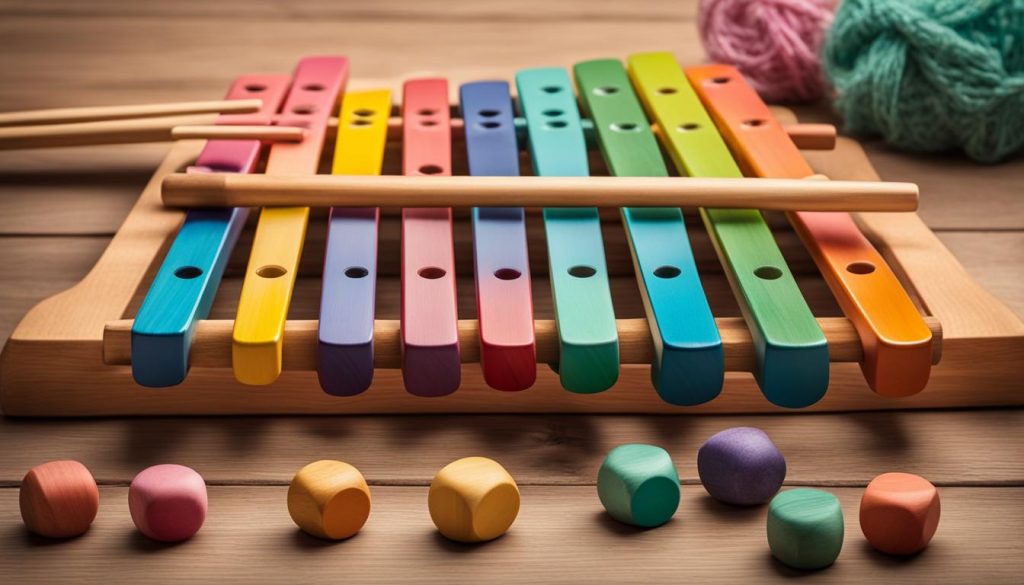Welcome to my guide on playing the xylophone for kids! In this article, I will explore the educational benefits of this fascinating instrument, its impact on hand-eye coordination, the different types of xylophones available for kids, and fun learning activities to enhance their musical skills. Let’s dive in and discover the joy of xylophone playing!
Playing the xylophone is not only a fun experience but also a great way for kids to learn and develop various skills. It can enhance their musical abilities and improve hand-eye coordination.
There are different types of xylophones designed specifically for kids, including toy xylophones and educational xylophones. Each type offers unique features and learning opportunities.
To make learning the xylophone enjoyable, I’ll share some exciting activities kids can engage in, such as playing simple melodies, learning the C-major scale, and practicing regularly.
Is the Xylophone Easy to Learn?
The xylophone is considered an easy instrument to learn, especially for beginners. Its colorful keys and simple layout make it accessible and appealing to children. Whether kids are interested in exploring music or looking to enhance their musical skills, learning to play the xylophone can be a fun and rewarding experience.
There are various resources available for kids to learn the xylophone. They can take lessons from a teacher who specializes in percussion instruments or utilize books and online tutorials. These learning materials provide step-by-step guidance, teaching kids the basic techniques and musical concepts required to play the xylophone.
One crucial aspect of learning any instrument is practice. Regular practice helps kids develop their skills, improve their hand-eye coordination, and build muscle memory. By setting aside dedicated practice time each day, children can steadily progress in their xylophone journey and achieve proficiency in playing this delightful instrument.
Table: Pros and Cons of Learning the Xylophone
| Pros | Cons |
|---|---|
| Easy to learn for beginners | Requires consistent practice to master |
| Enhances hand-eye coordination | May require additional investment for quality xylophone |
| Introduces kids to music and rhythm | Can be loud and disruptive if not played considerately |
| Provides a creative outlet for self-expression | Requires parental guidance for younger children |
Learning to play the xylophone can be a fulfilling and enriching experience for kids. With the right resources, guidance, and dedication, they can develop their musical skills, foster creativity, and find joy in making music with this charming instrument.
Benefits of the Xylophone for Kids’ Development
Playing the xylophone is not only a fun activity for kids but also offers numerous benefits for their overall development. From enhancing musical skills to improving hand-eye coordination and cognitive abilities, the xylophone proves to be an excellent instrument for young learners.
When children play the xylophone, they are exposed to various musical elements such as rhythm, melody, and pitch recognition. This promotes the development of their musical skills and helps them gain a better understanding of music. Kids can experiment with different notes and create their own melodies, fostering their creativity and self-expression.
The physical act of playing the xylophone requires hand-eye coordination and fine motor skills. As kids strike the colorful keys with mallets, they learn to coordinate their hand movements with visual cues, enhancing their motor skills. This can have a positive impact on their overall coordination and dexterity.
| Musical Skills | Hand-Eye Coordination | Cognitive Development |
|---|---|---|
| Enhances rhythm, melody, and pitch recognition | Improves hand-eye coordination and fine motor skills | Promotes memory improvement, concentration, and problem-solving skills |
The cognitive benefits of playing the xylophone are equally important. Regular practice helps children improve their memory as they memorize melodies and patterns. Focusing on playing the instrument also enhances concentration and attention span. Additionally, the xylophone requires kids to think strategically and problem-solve as they navigate different notes and sequences.
Overall, the xylophone offers a well-rounded learning experience for kids by developing their musical skills, coordination, and cognitive abilities. It is a versatile instrument that can be enjoyed by children of all ages and abilities, providing a platform for creativity and self-expression.
Different Types of Xylophones for Kids
When it comes to introducing young children to the joy of playing the xylophone, there are several different types of instruments available, each designed with specific age groups and skill levels in mind. From xylophones for toddlers to beginner xylophones for kids, there is a wide range of options to choose from.
Toddler Xylophones
For the youngest aspiring musicians, toddler xylophones are a perfect choice. These xylophones typically feature large and colorful keys that are easy to play and explore. They are designed to be durable and safe for little hands, allowing toddlers to create their own musical sounds and develop a sense of rhythm.
Preschooler Xylophones
Xylophones for preschoolers are slightly more advanced, offering a stepping stone between the simpler toddler versions and more sophisticated models. These xylophones often have a simpler design with fewer keys, allowing young children to start learning basic melodies and songs. Many preschooler xylophones also come with accompanying songs or learning materials, making the learning process even more engaging and enjoyable for kids.
Beginner Xylophones
When children are ready to take their xylophone skills to the next level, beginner xylophones provide the perfect platform for growth. These xylophones are made with sturdy materials and include a learning guide to help children start playing. They typically feature a wider range of keys and offer a more realistic playing experience, allowing kids to develop their musical abilities and explore more complex melodies.
Xylophone Sets
For a comprehensive introduction to music, xylophone sets for kids are an excellent choice. These sets often include additional percussion instruments, such as drums or tambourines, providing children with a complete musical ensemble. Xylophone sets offer a fun and interactive way for young learners to discover different sounds and rhythms, fostering a love for music and encouraging creativity.
| Type | Description | Features |
|---|---|---|
| Toddler Xylophones | Designed for the youngest aspiring musicians. | Large and colorful keys, durable construction. |
| Preschooler Xylophones | A stepping stone between toddler and more advanced xylophones. | Simpler design, fewer keys, accompanying songs or learning materials. |
| Beginner Xylophones | For children ready to take their xylophone skills to the next level. | Sturdy construction, wider range of keys, learning guide included. |
| Xylophone Sets | Comprehensive musical introduction with additional percussion instruments. | Includes xylophone and other instruments, promotes creativity. |
Xylophone Learning Resources for Kids
When it comes to learning the xylophone, there are various resources available to help kids develop their skills and musical abilities. From lessons with teachers to online tutorials, music learning apps, and xylophone learning games, children have a range of options to explore. These resources provide interactive and engaging ways for kids to learn and practice the xylophone at their own pace, whether at home or school.
One popular option for learning the xylophone is through lessons with teachers. A qualified instructor can guide kids through the fundamental techniques, such as proper hand placement and mallet technique, and help them progress to playing more advanced pieces. These lessons often include personalized instruction and feedback, allowing for tailored learning experiences.
For those who prefer self-paced learning, online tutorials are a convenient option. Many websites and YouTube channels offer free or paid tutorials specifically designed for kids. These tutorials provide step-by-step instructions, demonstrations, and practice exercises, making it easier for children to grasp the basics of playing the xylophone.
“Xylophone lessons offer a structured approach to learning the instrument, while online tutorials provide flexibility and convenience.”
Technology has also made it possible to learn the xylophone through music learning apps and xylophone learning games. These interactive tools combine fun and education by offering virtual xylophone keyboards, interactive lessons, and gamified learning experiences. Kids can learn at their own pace, track their progress, and even play along with popular songs.
Table: Xylophone Learning Resources
| Resource | Description |
|---|---|
| Lessons with Teachers | Personalized instruction and feedback from qualified instructors. |
| Online Tutorials | Step-by-step instructions, demonstrations, and practice exercises. |
| Music Learning Apps | Virtual xylophone keyboards, interactive lessons, and gamified learning experiences. |
| Xylophone Learning Games | Fun and engaging games that combine learning and playing the xylophone. |
With these diverse resources, kids can embark on a journey to master the xylophone and develop their musical abilities. Whether they choose to take lessons, explore online tutorials, or dive into interactive apps and games, the key is to practice regularly and enjoy the experience of making music with this enchanting instrument.
Making Music Fun with the Xylophone
Playing the xylophone opens up a world of musical possibilities for kids. Not only can they learn popular songs and melodies, but they can also unleash their creativity by composing their own tunes. Whether it’s playing a catchy xylophone song or creating unique melodies, the xylophone offers a fun and interactive way for kids to explore their musical talents.
In order to excel at playing the xylophone, kids need to develop their xylophone skills. This involves mastering proper mallet technique, understanding rhythm, and recognizing notes. With consistent practice and dedication, kids can enhance their musical abilities and become proficient xylophone players.
Showcasing their xylophone skills can be an exciting experience for kids. They can perform at school concerts, recitals, or even organize their own mini-concerts at home for family and friends. Performing on the xylophone not only allows kids to demonstrate their talent and hard work but also boosts their confidence and stage presence. It’s a rewarding opportunity for them to share their musical journey with others.
FAQ
Is learning to play the xylophone easy for kids?
Yes, the xylophone is considered an easy instrument to learn, especially for beginners.
How can kids learn to play the xylophone?
Kids can learn to play the xylophone by taking lessons from a teacher, using books or online tutorials.
What are the benefits of playing the xylophone for kids?
Playing the xylophone can enhance a child’s musical skills, hand-eye coordination, and cognitive development.
What types of xylophones are available for kids?
There are xylophones designed for toddlers, preschoolers, beginners, and xylophone sets that include additional percussion instruments.
Where can kids find resources to learn the xylophone?
Kids can find resources such as lessons, online tutorials, music learning apps, and games specifically designed for learning and playing the xylophone.
How can playing the xylophone be made fun?
Kids can make music fun with the xylophone by playing popular songs, creating their own melodies, and showcasing their skills through performances.





